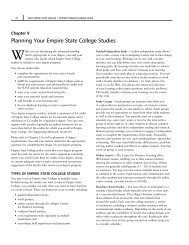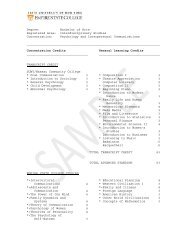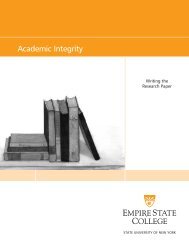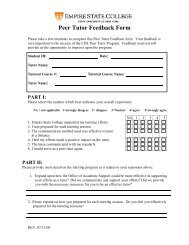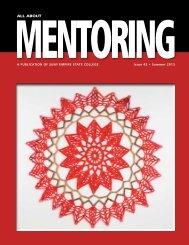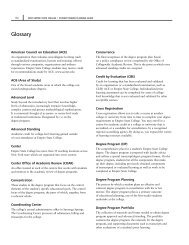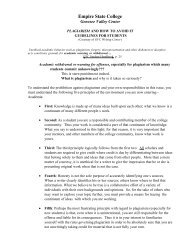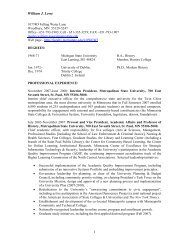All About Mentoring Spring 2011 - SUNY Empire State College
All About Mentoring Spring 2011 - SUNY Empire State College
All About Mentoring Spring 2011 - SUNY Empire State College
Create successful ePaper yourself
Turn your PDF publications into a flip-book with our unique Google optimized e-Paper software.
6<br />
Drawing 6: Croatia, “Ghosts and Skeletons in My<br />
Closet,” Girl, age 12, c. 1991.<br />
in laying a foundation for coping<br />
with the dreaded reality. Thus, both<br />
emotional well-being and dealing<br />
with realities can be bolstered<br />
through art, through the child’s<br />
own drawings. In this section, I<br />
present drawings illustrating fear<br />
and the different ways that children<br />
of war express it.<br />
Drawings 6 and 7 show two<br />
Croatian children’s fantasy<br />
representations of their fear,<br />
transforming it into an object of<br />
their own creation. Drawing 6 (c.<br />
1991) by a 12-year-old Croatian<br />
girl, who titled it “Ghosts and<br />
Skeletons in My Closet,” brings<br />
fear into her familiar place that<br />
once was safe – her home. In<br />
the form of skeleton/mummylike<br />
figures, evil enters through<br />
windows or from a closet, leaving<br />
blood on the floor.<br />
The child artists whose work is seen in<br />
Drawings 6 and 7 both seem focused on<br />
uncontrolled threat. Yet, it is actually<br />
positive that these children objectified the<br />
overwhelming threat present in the war<br />
zone. The ghosts and monsters were created<br />
by them and served them by focusing their<br />
attention on specific objects rather than on<br />
a generalized unease in their actual world.<br />
This is a first step in coping.<br />
Other children drew fear in a more personal<br />
or interior way, with human beings as the<br />
central figures, perhaps forcing the viewer<br />
to recognize that it is a child experiencing<br />
the emotions that were put on paper. The<br />
depiction of fear in Drawing 8 by a 6-yearold<br />
Serbian girl is particularly raw. The<br />
figure seems to hang in space, laid bare.<br />
Drawing 7: Croatia, “Fear,” Boy, age 12, c. 1991.<br />
Fear<br />
In addition to rendering memories of<br />
the horrors of enemy attacks and their<br />
experience of escape, children of war draw<br />
their fears, often in the form of animals,<br />
monsters and supernatural symbols such as<br />
ghosts. Fear consumes children during the<br />
extreme threat of war and recognizing it and<br />
making it the subject of one’s artwork can<br />
be helpful.<br />
Children’s depictions of their fears are clear<br />
and communicate easily to us, the viewers.<br />
Such drawings form an important vehicle<br />
within which children can tap and express<br />
their emotional life. Externalizing emotions<br />
in some way can allow a child to release<br />
some tension, can make a chaotic fearful<br />
situation more understandable by bringing<br />
meaning to it, can make part of the threat<br />
more manageable and allow the child to<br />
see herself as in control of some part of the<br />
danger and terror, and can be a key element<br />
The threat is all around and<br />
continues to invade the child’s<br />
private space. The viewer feels<br />
the closeness of the threat to the<br />
child’s psychological reality. The<br />
danger shown in Drawing 7, by<br />
an 11-year-old Croatian boy, is<br />
immediate and overwhelming,<br />
as made evident by the monster<br />
taking in excess of half the page and being<br />
more defined than the human figures. The<br />
enormous dark-eyed sharp-toothed monster<br />
attacks people who are<br />
drawn both smaller<br />
and in less detail. The<br />
emotional dominance<br />
of danger and fear<br />
as represented by the<br />
monster also is seen<br />
in the use of stark<br />
and varied colors, in<br />
contrast to duller and<br />
less varied colors of<br />
people. The white of<br />
the paper is the only<br />
background. This lack<br />
of context or scene<br />
creates a sense of<br />
being overwhelmed, of<br />
unbound fear.<br />
Drawing 8: Serbia, “Fear in Me,” Girl,<br />
age 6, c. 1991.<br />
Drawing 9: Terezin Concentration Camp, Girl, age 6, 1942-44.<br />
suny empire state college • all about mentoring • issue 39 • spring <strong>2011</strong>




